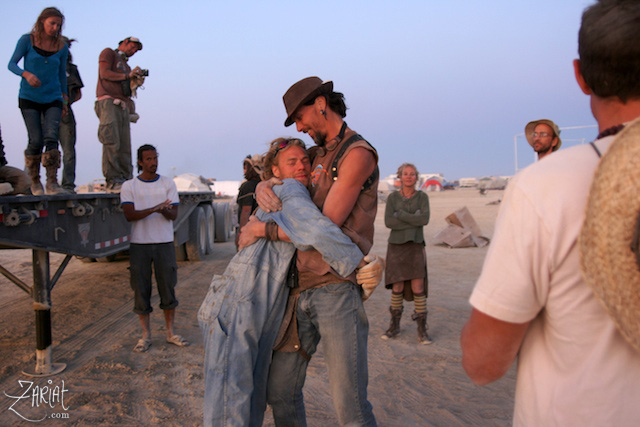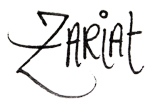Entheon Village at Burning Man 2008
Most Americans, when cooking at home, take for granted an indefinite supply of hot and cold running water and heat from the burner. In an energy outage or natural disaster, the severance of resources leaves the average person unable to prepare meals or even maintain basic hygiene. Coping with extreme situations such as these requires planning, resourcefulness, and willingness to adapt.
At the annual Burning Man festival, in Black Rock City, Nevada, participants voluntarily expose themselves to harsh climate conditions without the benefits of of institutionally-provided facilities (excepting ice and portable toilets). In order to survive for a week in the open desert, people must create their own shelters, showers, kitchens, and communal spaces. Structures must be resistant to high winds and fine dust. Facilities must be self-powered and use water efficiently. In order to meet these extraordinary challenges, groups of people often pool resources and labor into what are known as Theme Camps, such as the Chicago-based Entheon VIllage.
In 2006, Entheon Village was a new destination point at Burning Man, known for hosting high quality workshops and presentations. According to their website (www.EntheonVillage.com), Entheon Village was founded “as a collaboration between a group of Chicago-area burners formerly known as BOP Camp, MAPS, CoSM, the IAMU and many visionary artists, swiss meditators and folks who joined from 5 continents to help co-create the experience.” Over the last 3 years, the Entheon community has shown steady annual growth, and it has evolved into what may now be called a groundbreaking experiment in short-term self-sufficiency.
A Groundbreaking Experiment in Short-Term Self-Sufficiency
Approximately 500 people registered for Entheon Village at Burning Man in 2008. Villagers paid $333 as a membership fee, in addition to the cost of their Burning Man ticket, as a contribution for food, facilities, and services. All members were also required to volunteer for at least two work shifts, including one in the kitchen.
According to the ambitious vision of the group’s architects, Entheon Village intended to provide 3 meals a day, showers, toilet facilities, and much more for its members during the week-long event. All of the facilities were powered by biodiesel and housed in reusable mobile shipping containers. Greywater, compost, recycling, and the inescapable trash duly sorted and appropriately disposed. Construction and operational labor were to be provided by the community volunteers.
While some projects were fulfilled only to various degrees or on a fluctuating schedule, much to the chagrin of those who expected a seamless full-service experience, the Entheon Village community kitchen was regarded a consistent success. Villagers enjoyed three meals a day of primarily organic vegan cuisine, with both cooked and raw selections. A separate opt-in kitchen provided meat for a small minority of carnivores. A spacious shaded dining area served as a community meeting point, furnished with scavenged wooden church pews, sofas, and dust-reducing carpets.
Creating a Gourmet Oasis in the Nevada Desert
While organic vegan and raw cuisine may not be standard dining fare for everyone, especially at Burning Man, the chefs of Entheon Village prepared elaborate dishes that could grace the tables of fine urban restaurants. Oatmeal and granola were served with sliced fruit and fresh vegetable juices for breakfast. Hearty channa masala or tamales with rice-stuffed red peppers might be for dinner. Eclectic raw menu selections included creamy sprouted hummus, tangy sesame-kale salad, mountains of guacamole, and gooey desserts with cacao nibs and goji berries.
Eating raw foods has a multitude of benefits at any time, but in community kitchens the positive effects are even further multiplied. On an individual level, vitamins and minerals are most abundant and readily available in uncooked fruits and vegetables, which means that serving raw foods helps maximize the nutritional value of each meal. By purchasing a majority of food supplies as fresh fruits and vegetables in bulk, a group can save money and reduce waste (when compared to purchasing preserved foods), and also support local organic farmers. The exclusion of meat and dairy products eliminates a potentially heavy drain on refrigeration resources, as well as a possible source of harmful bacteria. Eating raw foods also means, of course, no cooking – which can provide a massive reduction in energy use.
Entheon Village cooked food and utilized hot water, but not without considering the most ecological and efficient methods. According to their website, the Entheon kitchen used solar ovens, recovered waste heat, and heated water via solar thermal radiation. All the serving dishes were either re-usable or compostable.
The kitchen, outfitted with an impressive array of commercial restaurant supplies, was housed in a 48-foot steel shipping container with two pop-out sides. The kitchen arrived in Black Rock City well over a week before Burning Man’s official opening to begin feeding the Entheon setup crew. While nourishing the growing Village, the kitchen also simultaneously provided the headquarters for Feed the Artists (FtA), a grassroots project created to gift meals to artists who come to the event early to set up large art installations. During the main week of Burning Man, informal reports indicated that the kitchen was serving well over 700 portions at many meals. The kitchen also remained intact and operational for most of the breakdown process, accumulating over 3 weeks in total as a self-sufficient gourmet restaurant in the desert.
Entheon Village, AKA ‘Uber-Namaste Camp’
At Entheon Village, there were biodiesel-powered air conditioners and private hot showers with a hidden greywater system. People were sweetening their coffee with coconut milk and agave nectar. When walking around the rest of the playa, where many people were happily taking showers out of black plastic bags and eating canned goods, the Entheon atmosphere seemed a bit surreal. A rumor was circulating that some people had nicknamed it ‘Uber-Namaste Camp’ – which is only funny, of course, if you know what ‘namaste’ means – basically incriminating you as the sort of person who might like agave nectar in your coffee too.
Namaste: a salutation commonly used in yoga and meditation practices, loosely translated from Sanskrit as ‘I am your humble servant’ or ‘I respect that divinity within you that is also within me’ (Source: Wikipedia.org)
The irony of the joke is that Entheon Village is actually an ‘Uber-Namaste Camp’ of sorts. The intention of creating a self-sufficient community space that exists purposefully to serve the needs of its inhabitants is a macroscopic version of meeting the needs of one. In its idealized form, each participant realizes a crucial role in the community, and the actions of the group sustain or even exceed the needs of the individual. The design of Entheon Village appears to be continually evolving in an effort to realize these goals, pursuing visionary projects with lofty community-based motives.



